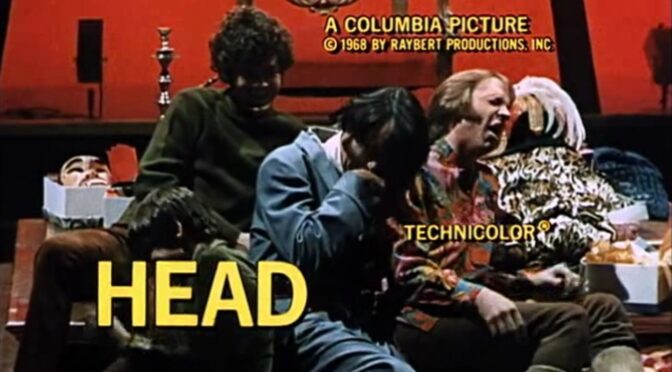
by Lorelei Marcus
"In this generation… Love is understanding, we gotta be free"
lyrics from 'for Pete's sake', performed by the Monkees, written by Joseph Richards and Peter Tork
The Beatles released an album called 'Rubber Soul' in America on December 6, 1965 and it heralded a new era. Practically overnight, the music, the fashion, and the youth all changed. Hemlines rose, hair grew out, psychedelia and rock started to merge, and like never before the teenagers of America became a visible force through their protests and love-ins and consumption.

Someone had the bright idea that this force could be profitable, and thus the Monkees were conceived: a fake band of four handsome, mop topped young men manufactured to sell Kellogg's cereal, concert tickets, and merchandise. They would star in a comedic TV show to create wider access and appeal, to turn them into a real happening deal, and it worked. Every week we tuned in to follow the exploits of the Monkees, narratively portrayed as deadbeat musicians trying to scrape by. It was fast-paced and fun, well executed and unique in that it featured intercut lip-synch segments with original songs by the Monkees. But the show really succeeded for the same reason it ultimately fell apart: the members of the Monkees are genuinely talented and driven musicians.

The legacy of the Monkees is great, with two seasons of the series, countless international live concerts, and several self-written albums. With such strong success, it was inevitable that the Monkees would eventually outgrow the narrow caricatures that first helped them to superstardom. Every member of the Monkees in some regard has raw talent in musicianship, composition, acting, and comedy. They each personally have the capacity to pursue new, innovative projects, and the ambition to do so. There is only one thing that restrains them from that independence: their own legacy.

Particularly in the eyes of the adoring fans, the Monkees are not brilliant creatives, but still silly poor musicians going on adventures to make a quick dollar. Particularly because of the manufactured nature of their origin, nobody expects anything more from them, and thus won't acknowledge what exists beyond the popular false image of the Monkees. Still, there will be, and has been, a transition from the Monkees to just Mickey, Davey, Mike, and Peter, and it is necessarily a destructive and torturous one. To be free and independent in image, they must destroy what they were, or else be confined by it forever.

Nothing makes this more evident than their new movie, Head, which not only hammers the theme of desire for freedom to its audience, but does its best to rend asunder everything that the Monkees used to be. The film is constructed as a series of vignettes which abstractly flow one into the other. Structure is given to the story by three disparate elements. First, the story is circular, with the Monkees literally ending in nearly the same place the movie begins, emphasizing the feeling of being trapped eternally.




Second, we as an audience are given glimpses at the beginning of the movie of everything that happens, artificially creating a sense of foresight, implicating the audience as complacent jailers as the Monkees continuously run in circles for our amusement.

Finally, the essence of each vignette is the same. Every scene is a different scenario of the various Monkee members trying to escape a contrived, television-like setting, which ties all the disparate moments together as one long interconnected attempt to extricate the Monkees from TV itself.



Some of the imagery of imprisonment is very literal, with the Monkees trapped in a big black box, or stranded in the desert without the reprieve of a cool beverage (in itself a play at subliminal marketing), or stuck on the fake set of a Western where the only way to exit is to tear a hole in the backdrop.

There are also more disturbing metaphorical elements that speak to the feelings of being commodified by the very role of famous celebrity. At the end of the one and only concert film the Monkees do in the movie, their stage is swarmed by rabid, screaming fans. The Monkees are subtly replaced by mannequins of their likeness, which are promptly and ruthlessly torn apart by the mindless, grasping swarm of fans. The horror of the moment is compounded by the fact that the music video that precedes it is intercut with actual news footage of victims of the Vietnam War, overlaid with the screaming teenage girls of the concert.


All of this serves to send a complex message to the audience of the film: one that reveals the artificial, facile nature of the Monkee television image when contrasted with the atrocities of the real world, and also demonizes the audience/fans by portraying them as passive and active destructive forces in their pursuit of that very escapist television. This stimulates a call to action to emerge from the cocoon that commoditized Western television provides, and to use the incredible energy of the youth to tear down the fantasies we are complacently spoonfed; it tells us to see the real world, with all the horrors that it entails, and to make change, just as the Monkees want to.

The Monkees themselves are part of this struggle, drifting in and out of character over the course of the movie. Sometimes they are the Monkees of the show, mindlessly filling their roles and facing an artificial enemy who appears in various vignettes (played byTimothy Carey). Other times, reality leaks through as the actors confront aspects of the roles that are distasteful or untrue, such as Peter being disturbed by the idea of hitting a woman, or the Monkees being forced to laugh at a cripple, or even Davey seeing a giant eye behind the mirror—a representation of the audience watching the illusion unfold.

There is only one moment of true clarity and personality in the whole film, when Peter gives his soliloquy as the Monkees are trapped (again) in the black box. His speech, given in silence and with the rapt attention of the other Monkees and the audience, is a refrain on opening the mind to escape and emerge free. It is the one oasis of peace in the movie.


But it does not last, and soon the Monkees are arguing and retracing their steps through all the previous scenes and all their previous prisons, until they reach the grim finale.
The film ends with the Monkees being chased by all the faux villains they've encountered and being cornered atop a high bridge. Without hesitation, Mickey jumps over the side, and soon the other Monkees follow. For a moment, it seems that the only escape is death.




But the Monkees don't die when they hit the water. Instead they plunge into a dreamlike world, free to swim and explore, refracted by strange colors and camera filters, as if their image is finally morphing into something new. But then the dream ends, and it is revealed that the Monkees are actually swimming in a fish tank. They bang on the glass as they are driven away by the 'director', the true, larger-than-life villain of the story. The credits roll and the Monkees are sealed to their Sisyphus-like fate.

It is a bitter and dark ending that successfully taints the happy and carefree image of the Monkees. Yet the nihilism is also refreshing in that it's reflective of the larger helplessness felt by the youthful generation. The stresses of assassinations and poverty and politics and the war underlie the suppressive hopelessness that creates both the depression and the need for fantasy television in the first place. The young are trapped and stifled by their very society; they need a world of media to escape into that grants the illusion of freedom. But the Monkees refuse to be that escape anymore. They want to move on and tell their own stories. They will no longer coddle us and in turn be coddled, because they have a right to an independent identity, and in that vein, so do we. Whether we follow them or not, they will forge a path. The only question is whether, while on their new path, they will be able to emerge from the corpse of their former images. Or if we, in our inability to let go, will drag them back to the grave where the brand that they killed remains.

I think the first step, if you haven't already, is to go watch Head for yourself. It's a bit grim, but also funny and brilliant and an editing masterpiece. The seamless transitions from scene to scene give the viewer the impression of riding a carousel; it's unlike anything else I've seen. It's also a glimpse into the real sentiments of the members of the Monkees, so if you're a fan, it's worth it just for that. But beyond the great acting and the technical execution, I think the true value of the movie comes from how it successfully encapsulates the growing restlessness of our changing society in a way that many art films can't. It has the advantage of the metanarrative that the history of the Monkees' name provides, and thus a richer mode of expression than any one standalone piece. You may find that it changes how you see the world, or at the very least, triggers some unconventional thoughts.
For everything Head tries to do and succeeds at doing, I give it five stars.




I am in complete agreement. This is a brilliant movie, the more so in reflection. I recently caught the Monkees TV special (scheduled opposite the Oscars, sadly), and it was progressive, too.
You're insights are so keen for one so young, Lorelei!! Kudos on a perfect breakdown of this movie. I just watched it with my husband for the first time and will do so again because I'm sure to see things I may have missed, with so much going on behind the scenes, quite literally! You will go far as a writer, I am sure! Keep it up and thank you writing this brilliant article! :-)